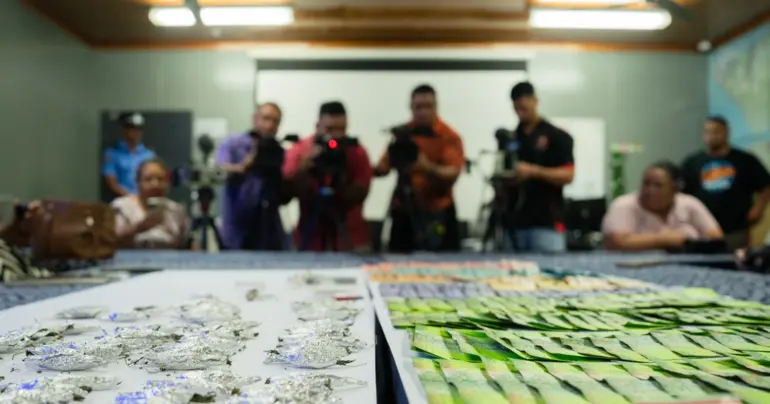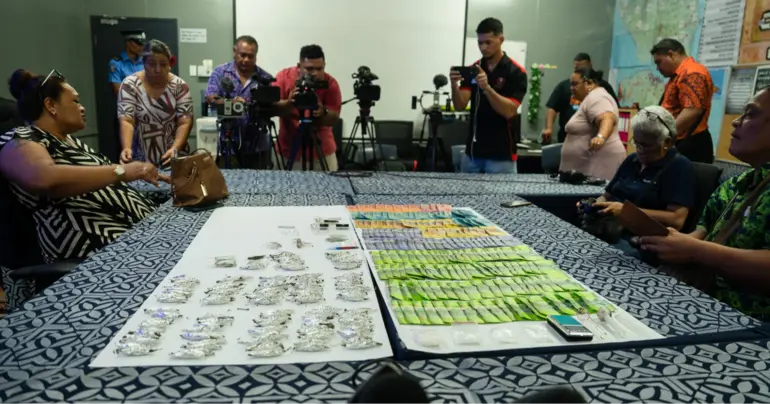Lightning strike zaps E.P.C. $375,000
 By Adel Fruean
•
23 May 2020, 9:00AM
By Adel Fruean
•
23 May 2020, 9:00AM
A lightning strike that devastated the the Fiaga Power Plant at the beginning of the year, causing widespread power blackouts in Samoa, cost $371,754.51.
This was confirmed by the General Manager of the Electric Power Corporation’s (E.P.C.), Tologata Tile Tuimaleali'ifano. During an interview with the Samoa Observer, he said the Corporation is already working on ensuring what happened is not repeated.
“We issued a tender to select a company to inspect Fiaga’s situation and come up with recommendations for improvement on its lightning protection,” he said.
Tologata added they awarded the contract to a New Zealand company.
“This study will enable them to come up with recommendations to improve the system," he said. “And once we have the recommendations then we do another tender for a company to implement the recommendations from the study and maybe by the end of this year. But we have already repaired everything that was damaged by the lightning.”
The cost of the damage will be covered by E.P.C's self-insurance worth around $16.5 million.
“We were the first corporation that came up with the idea of being self-insured," he said.
“When Cyclone Evan hit Samoa in 2012, it took two years for us to settle our claim from the insurance company and that meant over two years we could not do anything to repair the generators at Samasoni and Alaoa that were destroyed by the cyclone.
“We learned that not only we paid a huge amount of premium in terms of external service but it also took a lengthy amount of time to settle the claim but we wanted to quickly fix the generators.”
He added that E.P.C. started to save $2.5 million a year that by now should amount to around $16.5 million of self-insurance.
“In the process for the self-insurance claim, we cannot just use it whenever we want," he said. "So the incident or damages incurred at Fiaga and because it is categorised as a disaster.
“We have to give a submission to Cabinet and even though it is our money but it has to be approved by Cabinet because there has to be an accountable and transparent process to use the insurance money.”
Samoa is at 55 per cent to meeting its goal of 100 per cent renewable energy use by 2025, he also added.
“But we are working on the remaining 45 per cent; we have a tender currently underway that closes at the end of June because we have put together the remaining 45 per cent and have invited renewable source companies to assist with the remaining percentage.
“We need more solar with battery storage because we our system cannot withstand solar without storage, we are also looking at wind sources but it also must come with storage.
“It is because it will address the instability. The biggest wind farm that is currently being developed is at Mount Le Pu’e.”
There are a lot of barriers that E.P.C. is trying to overcome in achieving Samoa target by 2025.
“The first barrier is the technical issues of the system or instability. The disadvantage of solar and wind, these sources are called variable or transcend sources which means the output is not constant every time.
“And this means we need a source that can be an alternative when this fails, an example if a cloud covers the sun and the electricity produced drops from solar we need a source that can pick up the short fall or else we will experience power outages.
“We had battery storages previously installed at Fiaga and Faleolo which is trying to address this issue.”
However, sometimes it can be extreme that battery storages cannot pick up the short fall, added Tologata.
“At the moment we are running our diesel generators instead of having a 100 per cent output but it’s at 50 per cent because if solar drops in terms of producing electricity it can be picked up by the diesel generators otherwise it will lead to constant power outages.
“The biggest barrier is addressing technical issues that come with renewable sources.
“The second barrier is the cost; we are trying to lower the cost of electricity but when we started solar was expensive.
“The price for diesel ten years ago when we started developing our renewable energy was very expensive but after the impacts of COVID-19, the fuel prices has dropped.”
Tologata added that these are the risks that involve in these developments.
“It is because sometimes when developing, it is our objective not to depend on diesel because it is expensive but if Arabian countries choose to raise the prices we cannot control it.
“Sometimes renewable will be expensive but diesel will be cheap.
“But the Government’s long-term plan looks at Samoa depending on its own resources found at home to produce electricity.
“It is because if a war breaks out somewhere in the world and leads to vessels not being able to ship the diesel then Samoa can produce its own electricity.”
Another advantage of Samoa being able to produce its electricity with 100 per cent renewable and without diesel, it will save a lot in terms of the country’s foreign reserves that will be used to purchase much needed goods such as food items.
 By Adel Fruean
•
23 May 2020, 9:00AM
By Adel Fruean
•
23 May 2020, 9:00AM











